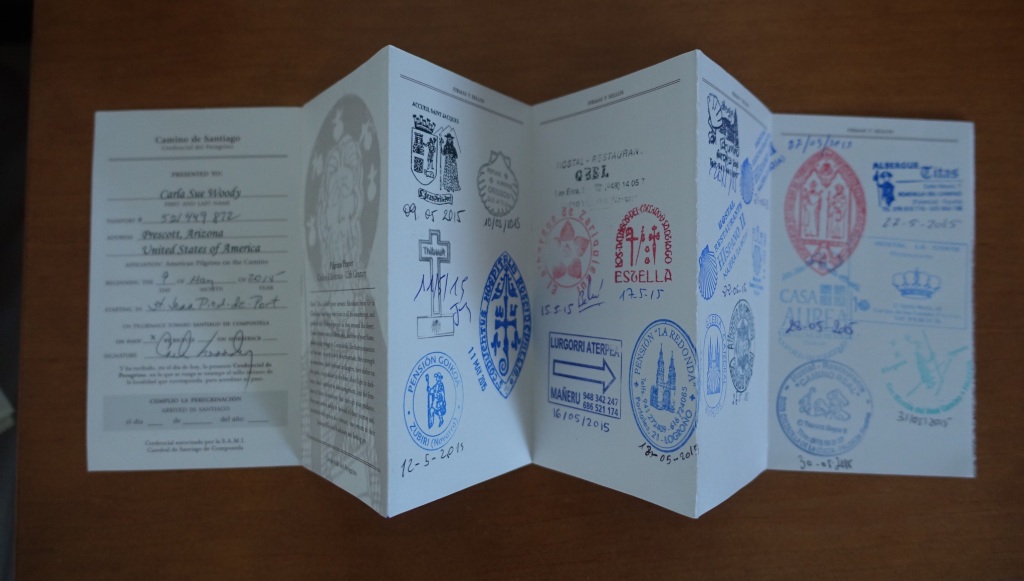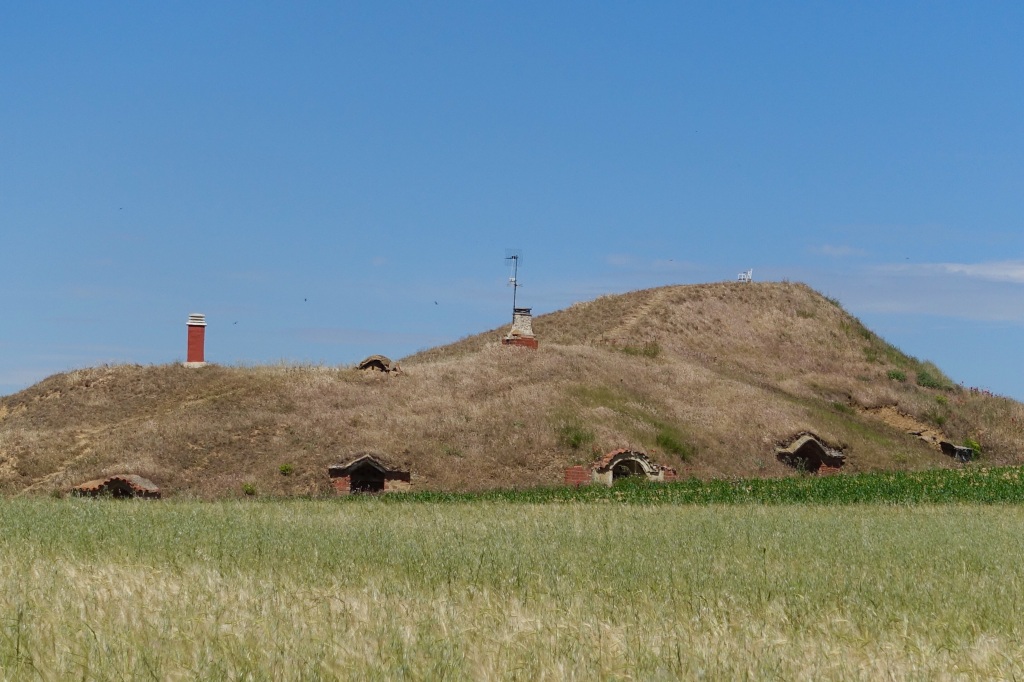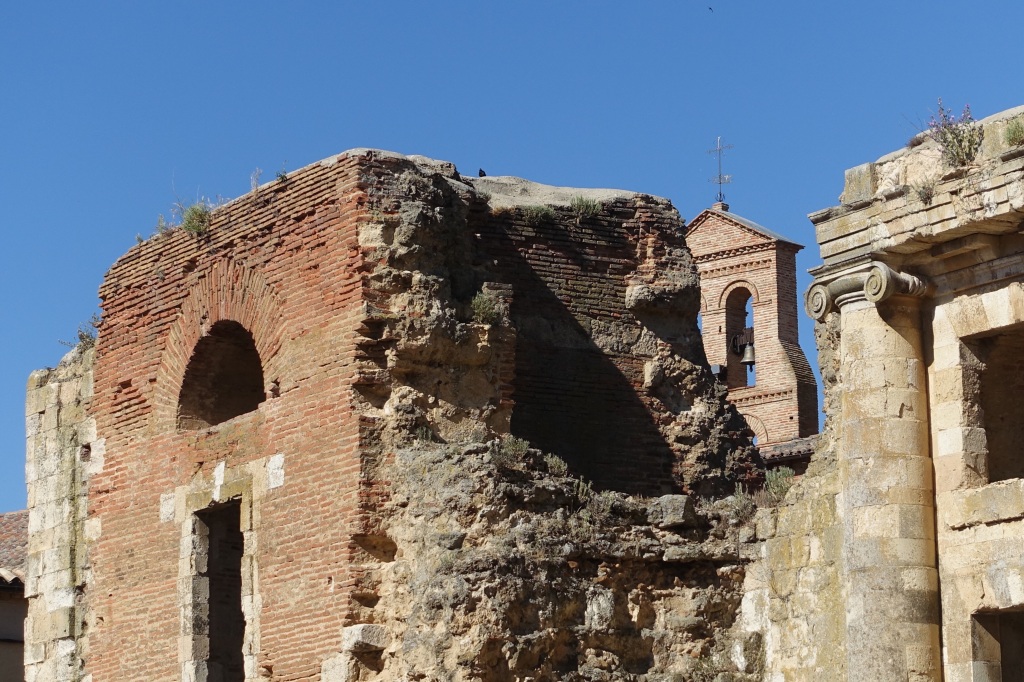Calzadilla de la Cueza-San Nicholas del Real Camino-Sahagun
Sahagun is said to be the halfway point for the Camino Frances…and I’m here. Arriving, I couldn’t help but notice all the swallows swooping through town and three storks nested on top of the old church now housing the municipal hostel. That and the celebratory halfway point was a good excuse as any to stay a couple of nights.
Before I left home I’d downloaded James Michener’s Iberia. I enjoyed his books many years ago, although they were often quite dense. One thing could be said for him in that he was faithful to the history and flavor of the region he wrote about, which is why I brought this one along. I finally opened it last night. It’s a combination travel diary and historical reference documenting his lifelong love affair with Spain and her people. There’s a very long section about the Camino. He’d traveled it three times. Below is one reminiscence.
“…Once I had walked sixty miles through this peninsula, carrying a pilgrim’s staff eight feet long, and as it swung methodically through the air…I had discovered what it must have been like physically to lug such a heavy staff across Spain; the kinesthetic sense of the staff swinging ever onward had drawn me forward with it. But not even the walk and the staff had told me how the pilgrim had felt inwardly, but here in Castrogeriz, as I swung along the road and into town, I became a pilgrim in imagination as well as in reality, and from that moment on I was to have a sense of what these distant hordes of people experienced as they picked their way from town to town across an inhospitable land, finding occasionally in a monastery or hospital a friendship so warm as to reward them for all the hours of isolation…”
I can really resonate with this passage. The walking stick does seem to pull me along. I’ve developed a thump-step-step-thump rhythm. And I can tell you it’s a comforting companion. Particularly when I left Carrion de Los Condes headed for Calzadilla de la Cueza. In the guidebook there was a warning that nothing but dusty road through endless fields existed along this stretch. No trees. No villages with a possibility of rest stop on this 17 km. Take plenty of water and something for lunch. The distance itself wasn’t beyond my capability but being without what was absent made for a tough day walking in solitude in the hot sun.
It’s amazing to me how some of the villages can hide in small dips in the landscape when it appears that the trek stretches on endlessly. I can tell you that Calzadilla was a welcome sight as was the great hospitality in the place I stayed. Many of those who run the albergues and hostels have walked the Camino themselves…and they know exactly what a pilgrim needs at the end of a long day.
Reading Michener’s encounters with local scholars and characters made a point. If you sprint through these places you don’t really experience the people who live there. The other pilgrims and those who service them…sure. But there are whole communities who open their arms and hearts. We pilgrims are guests and most of the locals treat us as such.
Particularly the older residents greet me in passing and say, “Buen Camino!” I got into Sahagun early and went to a cafe to wait for the tourist office to open for information on a hostel that would lodge me two nights. The cafe owner told me about a family-run hostel – “muy amable” – took me outside pointing down the street, indicating to just go straight. No street name. Well, pretty soon a few streets came together, and it was impossible to tell what straight was. I finally ended up on Plaza Mayor, looking quite lost I’m sure. An older gentleman approached me asking if I was looking for the Camino. I told him not today but showed him the paper with the hostel’s name. He motioned to come with him, talking all the while we walked, until he showed me a street and motioned. I thanked him and set out. But not before hearing him stop a very elderly woman going in my direction, asking her to make sure I got there. She did. This morning I returned to the cafe from yesterday for coffee and croissant. The owner’s face brightened. She beamed at me and said, “I was thinking about you so much and worrying if you would find it!” She was genuine.
Spain has had a very rough time in the economic downturn. Many of the villages look deserted, a number that were once rich strongholds of the Knights Templar now greatly diminished in size and importance. There has been an ebb and flow of pilgrims over the centuries. I am so glad this current upsurge has brought a new economy to these small burgs, making life a bit easier for these down-to-earth, hardworking people. I’m happy to spend my euros here.
If I have any regret, it’s that I don’t have better fluency in the language or the privilege that Michener had in being introduced to local sages and scholars…or his vast understanding of the art and architecture of the Middle Ages. His words on the page make the mysteries and meaning of those times come alive for me. I’d like to return and linger in each village and town, his writings on these places helping to ferret out what once existed and more appreciate what still does.



Oddly, I’ve never read Michener. Yet your description of his writing, and my experience of your own in this blog, causes me to want to do just that. I feel as though my senses are picking up on your actual experience. I can see it, smell it, and feel it. I’m loving this adventure! Thanks for allowing me along!
LikeLiked by 2 people
Nance, adventures are to be shared in my book…in as many ways as I can recreate them…with those who are interested. Very glad you are.
LikeLike
Michener–what an excellent companion on the Camino. You’ve been gone a month now, right? I imagine home seems very far away. Love it that the folk of Sahagun have taken you in.
LikeLiked by 1 person